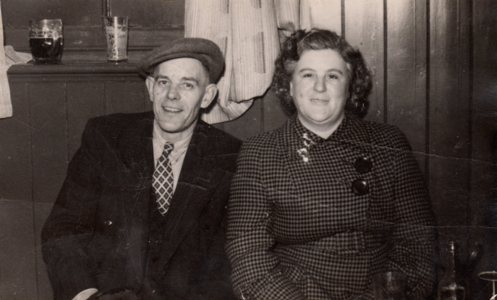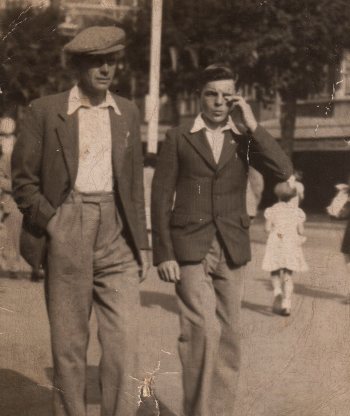Guardsman John William “Jack” Wigley
27763 Private 13th Company, Coldstream Guards
John William Wigley was born in 1898 at Chapel Yard, Nottingham, son of Horatio Wigley, a professional soldier born Radford, Nottingham and his wife Harriett (nee Winfield) of Pye Hill. John William had brothers and sisters Amy or Annie, Redvers Buller, Alice and William. In 1901 the family was living at New Westwood but father Horatio is not at home as he is serving in the Boer War. Horatio died in 1909, aged only 42 and is buried at Westwood, St Mary’s but there is no headstone. His wife Harriett is listed on the 1911 Census as a widow and working as a charwoman. The census states that Harriett and Horatio married in 1896 and that they had 8 children of whom 5 had survived. St Mary’s burials records the burial of a child Elizabeth Amelia Wigley, aged 18 months.
 Photo: John and his wife Eva.
Photo: John and his wife Eva.
John William was employed as a coal miner until he was called up for service, enlisting on 1st May 1918. He was aged 19 years and 4 months, had dark brown hair, grey eyes and a fresh complexion. His physical development was described as ‘good’ and his health as A1 although he had scars all over his abdomen, probably due to crawling in tunnels or cradling huge lumps of coal whilst coal mining. He gave his religion as Primitive Methodist and as he was single, his next of kin being his mother Harriett at New Westwood. John was a taller than average lad for his day, 5′ 8″ in height and therefore ideal material for the Coldstream Guards. He reported to Caterham Barracks, Surrey, training ground for guardsmen of all regiments where he undertook a more rigorous training than usual, lasting 20 weeks, comprising 12 weeks basic and 8 weeks battle training. On 24th October 1918 he was posted to the Provisional Battalion at Windsor but by this time the war was almost over. On 11th January 1919 he was discharged from the Army, being transferred to ‘Class Z’ as he had signed up for the duration of the war only. Perhaps it may have been John’s wish to remain in the Guards but at the end of the war there would have been many men surplus to military requirements.
In 1927, several years after WW1, John William married Eva Brown and they had sons Eric, Raymond, Stan, Malcolm and Christopher. In 1933 John’s mother Harriett died, aged 62 and is buried at Westwood, St Mary’s.
Photo: John and his son Raymond.John’s father Horatio born Macclesfield, Cheshire in 1867 was a regular in the Army. He enlisted with the Derbyshire Regiment on 27th June 1887 at Nottingham, service number 1947, rank Private. He was aged 20 and gave his occupation as carriage hand. He was 5′ 4″ tall, 124 lbs, and just like John had dark hair, grey eyes and a fresh complexion. Religion Church of England. He served for 12 years, spending 5 years in the East Indies and then at home in the UK for the last 5 years of his service, from 1895 to 1899, marrying Harriett in 1896 at Nottingham. He was discharged on 26th June 1899 to serve 4 years in the reserves but only 9 months later on 7th March 1900 was recalled for army service. He served in the Boer War in South Africa from 17th March 1900 to 21st July 1902 and was a recipient of the Queen’s South African Medal.
On the 21st February 1901, The ‘Free Press’ Newspaper published the article below and no doubt Horatio would have been included:- ‘ Westwood. Lantern Lecture. The Congregational Church was crowded on Monday night to witness a descriptive illustrated lantern lecture of the South African War. Mr. E. A. Towell ably manipulated the slides and explained the different pictures appearing on the screen, which included the battles of Belmont, Graspan, Colenso, Elandslaagte, Spion Kop, Magersfontein, Modder River, reliefs of Ladysmith, Kimberley, and Mafeking, and state entry into Bloemfontein and Pretoria. The portraits of the Westwood men now at the front were also shown and elicited cheers from the audience. The lecturer fully proved by the detailed account which he gave that he had a thorough knowledge of the events and incidents of the South African War.’
Horatio was discharged on 26th June 1903. He had named his second son born 1900, Redvers Buller Wigley after the Commander in Chief of British Forces South Africa. Horatio himself had been named after an uncle namesake of Lord Horatio Nelson, possibly an indication that this family’s military service went back through several generations. Certainly Horatio’s father William Wigley, grandfather to John William was also an Army regular and remarkably his military record is also still intact:-
William Wigley, born 1824 Radford, Notts attested at Nottingham in 1842 with the 55th Regiment of Infantry. He was aged only 16 years and 6 months, a boy entrant and gave his occupation as lace maker. He had dark brown hair, a fresh complexion and hazel eyes. He was also taller than average for the time, being 5′ 9″. He saw service in Gibraltar, for two years, Monte Video, South America for 10 years and in the Cape of Good Hope, Africa for 12 years. He was promoted to Corporal fairly rapidly after 6 years service and promoted to Serjeant by the relatively young age of 28 years, but 3 years later in 1855 something went amiss and William was subject of a court martial and reduced to the ranks. He held the rank of Private until he was made back up to Corporal in 1860 and in 1862 regained the rank of Serjeant. He also saw service at Aldershot, in Dublin and was finally discharged from the Isle of Wight in 1865 after 23 years service. After his Army days, he lived in Macclesfield, Cheshire for a short time where son Horatio was born and then moved back to his native Radford, Nottingham where he lived with his wife Elizabeth as an army pensioner.
A remarkable account of three generations of the same family all having served in the Army.










